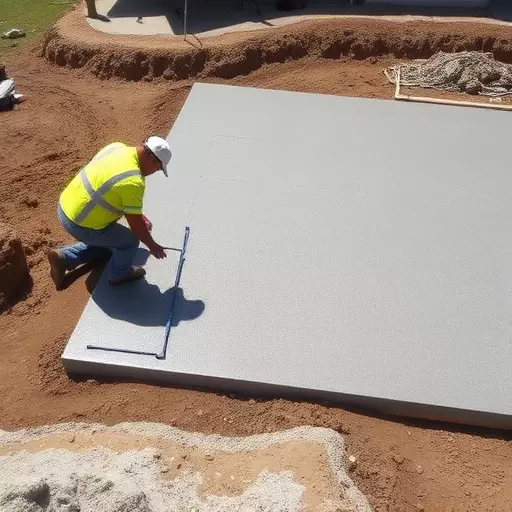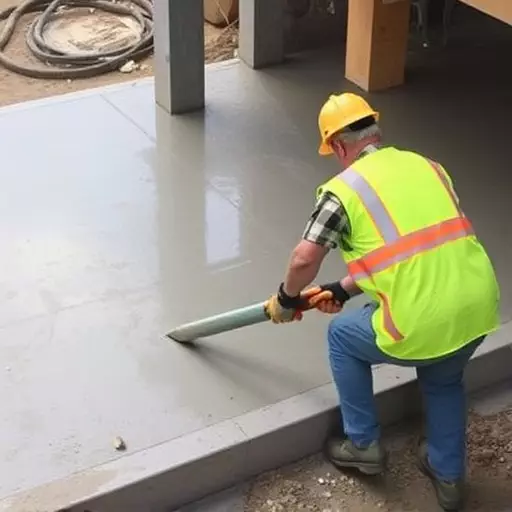The concrete slab pouring process in Toledo begins with meticulous site preparation, including clearing, compacting subgrade, and marking dimensions. Proper curing methods ensure optimal moisture levels for rapid hydration and strengthening. Key benefits of concrete slabs include weather resistance, load-bearing capabilities, and longevity. Optimal curing involves maintaining consistent moisture levels and monitoring temperature conditions. Avoiding common mistakes during preparation, such as inadequate moisture content and extreme temperatures, is crucial for structural integrity and maximizing benefits.
“Unleash the potential of your construction projects with a deep dive into the concrete slab curing process. This comprehensive guide explores the intricate steps from pouring the perfect slab in Toledo to uncovering its exceptional strengths and durability. Learn the art of preparing slabs, from expert techniques to essential precautions. Discover key practices for optimal curing, avoiding common pitfalls. By mastering these aspects, you’ll revolutionize your approach to concrete slab construction.”
- Concrete Slab Pouring Process Toledo: Understanding the Basics
- Concrete Slab Preparation Steps: A Comprehensive Guide
- Benefits of Concrete Slabs: Strength and Durability Unmatched
- Ensuring Optimal Curing: Key Techniques for Concrete Slabs
- Common Mistakes to Avoid During Concrete Slab Curing
Concrete Slab Pouring Process Toledo: Understanding the Basics

Pouring a concrete slab in Toledo involves a meticulous process that ensures structural integrity and longevity. It begins with careful preparation of the site, including clearing the area, compacting the subgrade, and marking out the exact dimensions of the slab. This foundational step is crucial as it sets the stage for the entire curing process.
Once the site is ready, the concrete mix is carefully poured into the forms, ensuring even distribution and minimal air pockets. After pouring, proper curing methods are initiated to maintain optimal moisture levels within the slab. This curing process involves strategies like covering the slab, spraying with curing agents, or utilizing heated blankets, all aimed at promoting rapid hydration and strengthening the concrete’s bond. Understanding these preparation steps and the benefits of proper curing is key to achieving high-quality, durable concrete slabs in Toledo.
Concrete Slab Preparation Steps: A Comprehensive Guide

Before beginning the concrete slab curing process, proper preparation is key to achieving optimal results. The concrete slab pouring process in Toledo starts with careful planning and execution. First, assess the site to ensure it meets the necessary criteria for a successful pour—level ground, adequate drainage, and access to water and utilities. Next, create a detailed plan outlining dimensions, layout, and any special considerations. This step is crucial as it forms the foundation for the entire project.
Once the planning is complete, clear the area of debris and obstructions, ensuring smooth access for equipment and materials. Prepare the subgrade by compacting it to create a stable base. This involves grading and leveling the soil to achieve the required consistency. Proper subgrade preparation enhances the slab’s structural integrity and promotes effective curing. Additionally, consider adding a moisture barrier or membrane to control water content, which is vital for the concrete slab preparation steps and overall benefits of concrete slabs.
Benefits of Concrete Slabs: Strength and Durability Unmatched

Concrete slabs offer unparalleled strength and durability, making them a top choice in construction projects, especially in Toledo where the concrete slab pouring process is meticulously executed. The benefits extend far beyond aesthetics; concrete slabs provide a solid foundation for various structures, from homes to industrial buildings. Their robust nature ensures longevity, resisting extreme weather conditions and heavy loads with ease.
Proper preparation is key to unlocking these advantages. This includes ensuring a level subgrade, correct mix design, and adequate moisture content during the pouring process. By following the concrete slab preparation steps diligently, contractors can guarantee that each slab meets the required specifications, contributing to the overall structural integrity of the project.
Ensuring Optimal Curing: Key Techniques for Concrete Slabs

Ensuring optimal curing is a critical step in the concrete slab pouring process Toledo professionals rely on to achieve high-quality results. After the concrete slab preparation steps are completed, the right curing techniques must be implemented to allow the concrete to develop its full strength and durability. This involves maintaining consistent moisture levels throughout the slab to promote chemical reactions that strengthen the concrete structure.
There are several key techniques to consider for optimal concrete slab curing. One of the most effective methods is to cover the freshly poured slabs with moisture-retaining blankets or membranes to prevent evaporation. Additionally, regular spraying or watering of the slab surface helps maintain the necessary humidity levels. Proper curing also includes monitoring temperature conditions, as concrete sets best within a specific temperature range. By following these preparation steps and employing appropriate curing techniques, contractors can maximize the benefits of concrete slabs, ensuring longevity, improved aesthetics, and enhanced structural integrity.
Common Mistakes to Avoid During Concrete Slab Curing

During the concrete slab curing process in Toledo, several common mistakes can be avoided if you understand and follow proper preparation steps. One of the most frequent errors is inadequate moisture content during the initial stages. Concrete slabs require a consistent, controlled water supply to hydrate the cement grains effectively. Insufficient watering can lead to weaker, more porous slabs that are less durable.
Another mistake to steer clear of is improper temperature control. Concrete sets best between 50-90°F (10-32°C). Extreme temperatures can slow down curing or cause surface drying too quickly, resulting in cracks and uneven hardness. Additionally, neglecting regular monitoring and maintenance can pose issues. Regular inspection ensures that the slab is free from contaminants, and proper maintenance helps address any potential problems early on, maximizing the benefits of concrete slabs, such as enhanced structural integrity and longevity.


